
34. If the electric field is in the positive xdirection and has a magnitude given by E=Cx2, where
Cis a constant, then the electric potential is given by V=:
A. 2Cx
B. −2Cx
C. Cx3/3
D. −Cx3/3
E. −3Cx3
ans: D
35. An electron goes from one equipotential surface to another along one of the four paths shown
below. Rank the paths according to the work done by the electric field, from least to greatest.
90 V 80 V 70 V 60 V 50 V
..............................................................................................................
.
.
.
.
..
.
.
.
.
.
.
.
.
.
.
.
.
.
.
.
..
.
.
.
..
.
.
.
.
.
.
.
.
.
.
.
.
.
.
.
....................
...
.
.
.
.
.
.
.
.
.
.
.
.
.
.
.
.
.
.
.
.
.
.
.
.
.
.
.
.
.
.
.
.
.
.
.
.
.
.
.
.
.
.
.
.
.
.
.
.
.
.
..........................................................
4......................................
.
.
.
.
..
.
.
.
.
.
.
.
.
.
.
.
.
.
.
...
.
.
.
..
.
.
.
.
.
.
.
.
.
.
.
.
.
.
........................
.
.
.
.
.
.
.
.
.
.
.
.
.
.
.
.
.
.
.
.
.
.
.
.
.
.
.
.
.
.
.
.
.
.
.
.
.
.
.
.
.
.
.
.
.
.
.
.
.
.
...
....................................................................................................................................................................................................... 3
.......................................
.
.
.
..
.
.
.
.
.
.
.
.
.
.
.
.
.
.
.
.
.
.
.
.
..
.
.
.
.
.
.
.
.
.
.
.
.
.
.
.
..................................... 2
..............................................................................................................
.
.
.
.
..
.
.
.
.
.
.
.
.
.
.
.
.
.
.
.
..
.
.
.
..
.
.
.
.
.
.
.
.
.
.
.
.
.
.
.
............................................................................................................. 1
A. 1, 2, 3, 4
B. 4, 3, 2, 1
C. 1, 3, 4 and 2 tie
D. 4 and 2 tie, then 3, then 1
E. 4, 3, 1, 2
ans: D
36. The work required to carry a particle with a charge of 6.0 C from a 5.0-V equipotential surface
toa6.0-V equipotential surface and back again to the 5.0-V surface is:
A. 0
B. 1.2×10−5J
C. 3.0×10−5J
D. 6.0×10−5J
E. 6.0×10−6J
ans: A
37. The equipotential surfaces associated with a charged point particles are:
A. radially outward from the particle
B. vertical planes
C. horizontal planes
D. concentric spheres centered at the particle
E. concentric cylinders with the particle on the axis.
ans: D
Chapter 24: ELECTRIC POTENTIAL 361
Simpo PDF Merge and Split Unregistered Version - http://www.simpopdf.com

38. The electric field in a region around the origin is given by n
E=C(xˆ
i+yˆ
j), where Cis a
constant. The equipotential surfaces in that region are:
A. concentric cylinders with axes along the zaxis
B. concentric cylinders with axes along the xaxis
C. concentric spheres centered at the origin
D. planes parallel to the xy plane
E. planes parallel to the yz plane
ans: A
39. The electric potential in a certain region of space is given by V=−7.5x2+3x, where Vis in
volts and xis in meters. In this region the equipotential surfaces are:
A. planes parallel to the xaxis
B. planes parallel to the yz plane
C. concentric spheres centered at the origin
D. concentric cylinders with the xaxis as the cylinder axis
E. unknown unless the charge is given
ans: B
40. In the diagram, the points 1, 2, and 3 are all the same very large distance from a dipole. Rank
the points according to the values of the electric potential at them, from the most negative to
the most positive.
•
•
•
1
2
3
np.
.
.
.
.
.
.
.
.
.
.
.
.
.
.
.
.
.
.
.
.
.
.
.
.
.
.
.
.
.
.
.
.
.
.
.
..
.
.
.
.
.
.
.
.
.
.
.
.
.
.
.
.
.
.
.
.
.
.
.
.
.
.
.
.
.
.
.
.
.
A. 1, 2, 3
B. 3, 2, 1
C. 2, 3, 1
D. 1, 3, 2
E. 1 and 2 tie, then 3
ans: D
362 Chapter 24: ELECTRIC POTENTIAL
Simpo PDF Merge and Split Unregistered Version - http://www.simpopdf.com

41. A particle with charge qis to be brought from far away to a point near an electric dipole. No
work is done if the final position of the particle is on:
A. the line through the charges of the dipole
B. a line that is perpendicular to the dipole moment
C. a line that makes an angle of 45◦with the dipole moment
D. a line that makes an angle of 30◦with the dipole moment
E. none of the above
ans: B
42. Equipotential surfaces associated with an electric dipole are:
A. spheres centered on the dipole
B. cylinders with axes along the dipole moment
C. planes perpendicular to the dipole moment
D. planes parallel to the dipole moment
E. none of the above
ans: E
43. The diagram shows four pairs of large parallel conducting plates. The value of the electric
potential is given for each plate. Rank the pairs according to the magnitude of the electric field
between the plates, least to greatest.
−20 V +70 V
1
+20 V +70 V
2
−10 V +90 V
3
+30 V +90 V
4
A. 1, 2, 3, 4
B. 4, 3, 2, 1
C. 2, 3, 1, 4
D. 2, 4, 1, 3
E. 3, 2, 4, 1
ans: D
Chapter 24: ELECTRIC POTENTIAL 363
Simpo PDF Merge and Split Unregistered Version - http://www.simpopdf.com

Chapter 25: CAPACITANCE
1. The units of capacitance are equivalent to:
A. J/C
B. V/C
C. J2/C
D. C/J
E. C2/J
ans: E
2. A farad is the same as a:
A. J/V
B. V/J
C. C/V
D. V/C
E. N/C
ans: C
3. A capacitor C “has a charge Q”. The actual charges on its plates are:
A. Q,Q
B. Q/2, Q/2
C. Q,−Q
D. Q/2, −Q/2
E. Q,0
ans: C
4. Each plate of a capacitor stores a charge of magnitude 1 mC when a 100-V potential difference
is applied. The capacitance is:
A. 5 µF
B. 10 µF
C. 50 µF
D. 100 µF
E. none of these
ans: B
5. To charge a 1-F capacitor with 2 C requires a potential difference of:
A. 2 V
B. 0.2V
C. 5 V
D. 0.5V
E. none of these
ans: A
364 Chapter 25: CAPACITANCE
Simpo PDF Merge and Split Unregistered Version - http://www.simpopdf.com

6. The capacitance of a parallel-plate capacitor with plate area Aand plate separation dis given
by:
A. 60d/A
B. 60d/2A
C. 60A/d
D. 60A/2d
E. Ad/60
ans: C
7. The capacitance of a parallel-plate capacitor is:
A. proportional to the plate area
B. proportional to the charge stored
C. independent of any material inserted between the plates
D. proportional to the potential difference of the plates
E. proportional to the plate separation
ans: A
8. The plate areas and plate separations of five parallel plate capacitors are
capacitor 1: area A0, separation d0
capacitor 2: area 2A0, separation 2d0
capacitor 3: area 2A0, separation d0/2
capacitor 4: area A0/2, separation 2d0
capacitor 5: area A0, separation d0/2
Rank these according to their capacitances, least to greatest.
A. 1, 2, 3, 4, 5
B. 5, 4, 3, 2, 1
C. 5, 3 and 4 tie, then 1, 2
D. 4, 1 and 2 tie, then 5, 3
E. 3, 5, 1 and 2 tie, 1, 4
ans: D
9. The capacitance of a parallel-plate capacitor can be increased by:
A. increasing the charge
B. decreasing the charge
C. increasing the plate separation
D. decreasing the plate separation
E. decreasing the plate area
ans: D
10. If both the plate area and the plate separation of a parallel-plate capacitor are doubled, the
capacitance is:
A. doubled
B. halved
C. unchanged
D. tripled
E. quadrupled
ans: C
Chapter 25: CAPACITANCE 365
Simpo PDF Merge and Split Unregistered Version - http://www.simpopdf.com


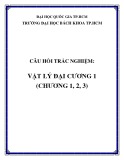
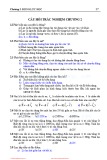
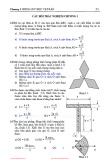

![Câu hỏi trắc nghiệm Cơ kỹ thuật [chuẩn nhất]](https://cdn.tailieu.vn/images/document/thumbnail/2014/20141226/gonvo_93/135x160/4731419585192.jpg)

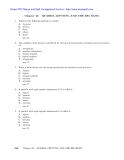
![Tuyển tập ngân hàng đề kiểm tra Vật lý (Physics Test Bank) chọn lọc [năm]](https://cdn.tailieu.vn/images/document/thumbnail/2012/20120227/kata_3/135x160/physics_test_bank_split_43_8303.jpg)
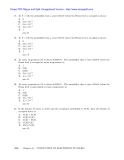









![Bộ câu hỏi lý thuyết Vật lý đại cương 2 [chuẩn nhất/mới nhất]](https://cdn.tailieu.vn/images/document/thumbnail/2025/20251003/kimphuong1001/135x160/74511759476041.jpg)
![Bài giảng Vật lý đại cương Chương 4 Học viện Kỹ thuật mật mã [Chuẩn SEO]](https://cdn.tailieu.vn/images/document/thumbnail/2025/20250925/kimphuong1001/135x160/46461758790667.jpg)




